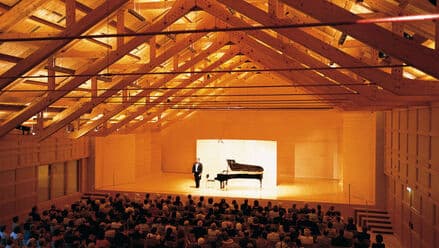Inspirations Behind Kaija Saariaho: D’OM LE VRAI SENS
The six Unicorn tapestries held at the Cluny Museum in Paris are an allegory of the five senses, through a meditation on earthly pleasures and courtly culture. Framed around the idea of the Lady and the Unicorn, and the belief that only virgins could attract unicorns, the 15th-century tapestry takes each of the five senses to create a scene.
The cartoons are attributed to the painter Jean d’Ypres, who was active in Paris around 1480 to 1510. The coat of arms of the Le Viste family of Lyon, which appears in the tapestry, indicates that the recipient was Antoine II, an important figure at the courts of Charles VIII, Louis XII, and François I. It was probably made around 1500 (not 1480, as previously believed). The order of the tapestries has never been established. There are also some allegorical linkages with the 13th-century romans by Guillaume de Lorris, Le Roman de la Rose.
The same woman appears in all the tapestries, each time in new clothing. On 4 tapestries, she has a smaller companion. The companion’s clothing and jewellery all point to her as a ‘demoiselle’, a person in the entourage of a queen or princess. Both the hairstyles, with a lock of hair raised on the front of the head, known as ‘aigrette’, and the twisted and linked chains on the jewellery are indicative of fashions of 1500.
The background gives them the name of ‘mille-fleurs’ tapestries. The plants and animals added in the background have allegorical significance. Carnations and roses lead us to a garden of love.
The clarinet concerto created by Kaija Saariaho (1952–2023) based on the tapestries is called D’OM LE VRAI SENS (Man’s True Sense) – this title will be discussed later.

Kaija Saariaho
She started work in the fall of 2009, and the work received its premiere in Helsinki on 8 September 2010, with clarinet soloist Kari Kriikku and the Finnish Radio Symphony Orchestra under the conductor Sakari Oramo. The work is dedicated to Kari Kriikku.
In the first tapestry, L’Ouïe (Hearing), The Lady plays a portative organ while her companion works the bellows to provide air to the pipes. The table is covered with an oriental carpet. A lion and a unicorn hold the La Viste coat of arms as flags, and at their feet are rabbits and dogs.
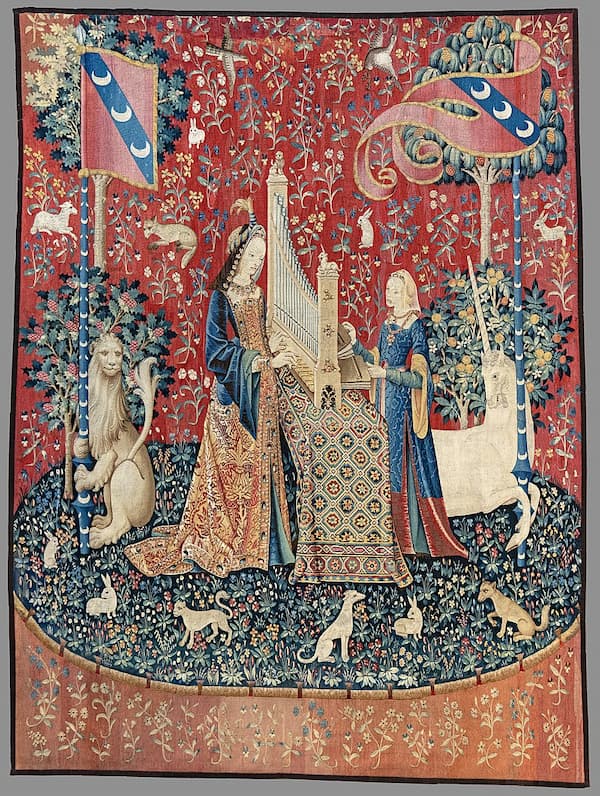
Unicorn Tapestries: L’Ouïe, 1500 (Paris: Cluny Museum)
In the music, the clarinet rouses the calm orchestra. The clarinet is not on stage but is somewhere in the hall. The clarinettist may be in the audience or behind it, but must be out of sight.
Kaija Saariaho: D’OM LE VRAI SENS – I. L’Ouïe (Kari Kriikku, clarinet; Finnish Radio Symphony Orchestra; Sakari Oramo, cond.)
La Vue (Sight) shows the lady holding up a mirror, and the smiling unicorn gazes upon its reflection.
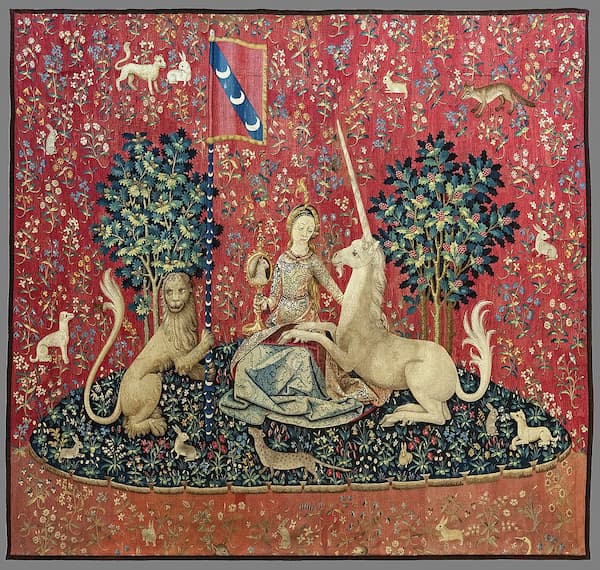
Unicorn Tapestries: La Vue, 1500 (Paris: Cluny Museum)
Sight, the second movement, opens up a more mobile landscape. The clarinettist approaches the state, and the orchestra positions itself behind the soloist to develop the musical motifs.
Kaija Saariaho: D’OM LE VRAI SENS – II. La Vue (Kari Kriikku, clarinet; Finnish Radio Symphony Orchestra; Sakari Oramo, cond.)
L’Odorat (Smell) is about flowers – the lady stands, fashioning a wreath of flowers while her companion holds a tray of other flowers. Behind the lady, a monkey is smelling a flower from her flower basket.

Unicorn Tapestries: L’Odorat, 1500 (Paris: Cluny Museum)
Now the clarinettist changes positions with the orchestra, moving to stand behind them, on a podium if needed.
Kaija Saariaho: D’OM LE VRAI SENS – III. L’Odorat (Kari Kriikku, clarinet; Finnish Radio Symphony Orchestra; Sakari Oramo, cond.)
In Le Toucher (Touch), the lady stands with her hand on the head of a unicorn wearing a La Viste shield; her other hand holds the La Viste pennant. To her right is a lion also with a La Viste shield. Behind her are a monkey, a leopard, and other animals.
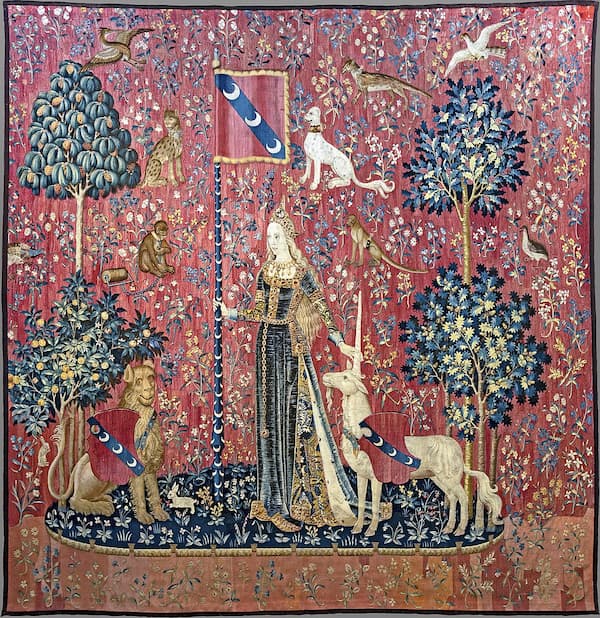
Unicorn Tapestries: Le Toucher, 1500 (Paris: Cluny Museum)
The clarinettist is in motion, starting behind the orchestra and approaching the front of the stage.
Kaija Saariaho: D’OM LE VRAI SENS – IV. Le Toucher (Kari Kriikku, clarinet; Finnish Radio Symphony Orchestra; Sakari Oramo, cond.)
Le Gout (Taste) shows the lion and the unicorn rampant, standing on their rear feet. The lady has given a sugared almond to a parrot, which holds the sweet in its claw. The unicorn looks at the viewer while the lion looks at the lady. The monkey, up front, is also eating sweets. The lady’s little dog sits on her robe, looking up eagerly.
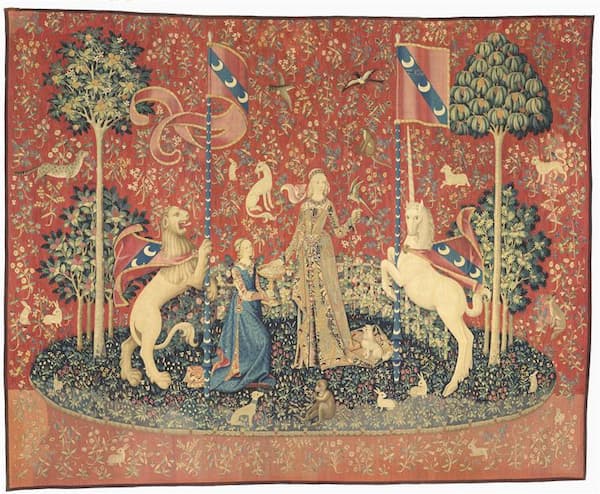
Unicorn Tapestries: Le Goût, 1500 (Paris: Cluny Museum)
The clarinettist now takes a central position, either in the middle of the orchestra or in front, raised on a podium if needed.
Kaija Saariaho: D’OM LE VRAI SENS – V. Le Goût (Kari Kriikku, clarinet; Finnish Radio Symphony Orchestra; Sakari Oramo, cond.)
The final tapestry, À mon seul désir (To My Only Desir), is in a different style from the other pieces. The Lady stands in a pavilion, putting a necklace into a chest held by her companion. This is the only image where the lady is seen smiling. The tent is held open by the lion and the unicorn. This is also the largest of the tapestries, 3.80 m × 4.64 m (12.5 ft × 15.2 ft); only Le Gout comes close at 3.75 m × 4.60 m (12.3 ft × 15.1 ft). The writing across the top of the pavilion, A MON SEUL DESIR, was a common motto in the age of chivalry and frequently appears on other artworks.
The meaning of this tapestry is unrelated to the five senses, but the imagery of placing a necklace in the chest could indicate her renouncing the passions aroused by the other senses or an assertion of her free will. It all depends on whether you see her picking up or putting down the necklace. By standing in the blue tent, the lady stands apart from the mythical world of the unicorn. Whereas in the other tapestries, all the animals were engaged with the sense being displayed, in the final tapestry, only the women are engaged with the necklace and the chest.
The use of the tent and an interior has also led to a reading of the final tapestry as meaning the heart. In medieval literature, the heart stood atop the 5 senses. If the 5 senses give us the experience of the exterior world, it is the heart that is the key to the internal world.

Unicorn Tapestries: À mon seul désir, 1500 (Paris: Cluny Museum)
When the letters of À mon seul désir are rearranged as an anagram, one answer is D’om le vrai sens (Man’s true sense), the title of Saariaho’s work. For this movement, the clarinettist stands in front of the orchestra and leaves the stage. The violin parts are written so that the musicians can leave their places, too.
The final movement, as indicated by the title, functions as a synthesis of what has passed before.
Kaija Saariaho: D’OM LE VRAI SENS – VI. À mon seul désir (Kari Kriikku, clarinet; Finnish Radio Symphony Orchestra; Sakari Oramo, cond.)
The movement of the clarinettist through the hall and the orchestra provided the composer with an interesting and unexpected outcome. For her, the work began to come alive in its space and the clarinet itself became the unicorn – unique and ‘playing only some of its music in the soloist’s position’.
The tapestries were only discovered in 1841 by the author Prosper Mérimée at Boussac Castle. In 1844, George Sand saw the tapestries and made them famous through her novel Jeanne. They finally were placed in a stable environment in 1852, when they were acquired by the Musée de Cluny in Paris. Extensive conservation and reconstruction of the tapestries followed.
For more of the best in classical music, sign up for our E-Newsletter


